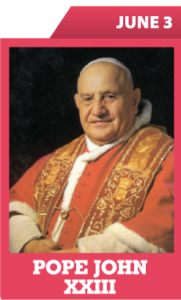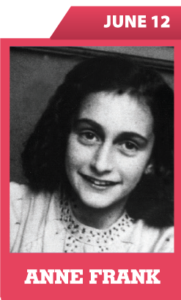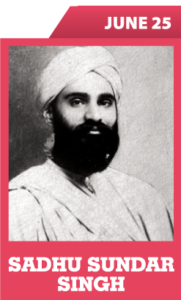Here are four inspiring human beings who displayed an exceptional dose of humanity, wisdom and goodness. Their death anniversaries occur this month.

People referred to him simply as “Good Pope John.” When he died on June 3, 1963, a newspaper published a drawing of the earth in mourning, with the caption, “A death in the family.”
How did Pope John conquer the hearts of so many people—both inside and outside the church?
When he was elected Pope, at age 76, several “experts” saw him simply as a transitional pope. He had not held any key office in the curia. He was the third of thirteen children of a poor farmer in a North Italian village. He had been posted in faraway places.
But, wherever he was posted, he went obediently, related to people, and won the confidence of other Christians and persons of different faiths.
His unexpected decisions were revolutionary: the first Synod in the diocese of Rome; the Second Vatican Council; appointment of a delegate to the World Council of Churches; receiving Kruschev’s daughter and son-in-law in private audience.
At the Council, where he spoke little, he insisted that better results are achieved through mercy than through condemnations. He insisted that the church needed updating, and greater openness to the modern world. He said publicly that he did not agree with the “prophets of doom,” who saw everything in the world with suspicion and fear.
People—both within and outside the Church—warmed up to his evident goodness and transparency. When, for instance, he went to the Central Jail in Rome and spoke to the prisoners, he put aside the prepared text, and spoke from the heart, “I am John, your brother,” he told the prisoners. “I place my heart near your heart.” Hardened prisoners wept.
So did the world when he died.
————————————————————————————————————————————————————————————————————————————–

Who has not heard of Anne Frank and her diary!
Anne was the daughter of Otto Frank, a well-to-do Jewish businessman from Frankfurt. When the family saw the growing attacks on Jews in Germany, they moved to Amsterdam in Holland, where they felt free.
But the situation changed in 1942, when all Jews were asked to report to the Nazi centres. The family then went into hiding in a little “annexe” to a building, where they lived in secret. Friends supplied them food. It is in this claustrophobic setting that Anne, then thirteen years old, started writing her diary.
Despite the violence and despair in the world outside, and the cramped, damp, uncomfortable conditions within their little box of a house, Anne wrote with optimism and hope, even humour.
The Frank family lived in the annexe from 1942 until 1944, when their hiding place was betrayed to the Nazi authorities. The family was arrested and sent to Nazi concentration camps, where men and women were separated. The mother died first. Anne and her sister died later, in another camp. Otto, the father, survived, and went to Amsterdam, where a friend of theirs had kept Anne’s diary. Published under the title, The Diary of a Young Girl, it has been translated
into sixty-seven languages.
The diary reveals Anne’s extraordinary capacity to find hope and courage even in the most trying circumstances, and to believe in love in the face of virulent hatred. As she wrote on July 15, 1944: “I see the world being slowly transformed into a wilderness; I hear the approaching thunder that, one day, will destroy us too. I feel the suffering of millions. And yet, when I look up at the sky, I somehow feel that everything will change for the better, that this cruelty too shall end, that peace and tranquility will return once more.”
Anne Frank was also able to write this sentence, “In spite of everything, I still believe that people are really good at heart.”
————————————————————————————————————————————————————————————————————————————–

Thomas More had everything a man can wish for: intelligence, education, influence, a loving family, an enviable career, and deep religious faith.
He was head of his time. At a time when women were not sent for higher education, he educated his daughters in Greek and Latin, and their erudition impressed scholars. He was an affectionate father, who wrote loving letters to his family when he was away from home.
More held the highest office in the land: Chancellor of England. But he would not compromise on matters of conscience. When King Henry VIII wanted to divorce his legally wedded wife and marry another, and declared himself head of the church in England, More would not agree. For this “crime,” he was arrested, jailed and beheaded.
Even at his execution, More did not lose his composure nor his sense of humour. Weakened by the cold, hunger and dirt of the prison, he struggled to climb the steps to the scaffold where he was to be beheaded. He said to the official, “I pray you, Mr Lieutenant, see me safe up; and for my coming down, I can shift for myself”; while on the scaffold he declared that he died “the king’s good servant, and God’s first.”
————————————————————————————————————————————————————————————————————————————–

Sundar Singh was born into a rich Sikh family. His mother, a very devout Sikh, made him learn the Bhagavad Gita in Sanskrit by the time he was seven. She took him to a guru for his guidance, and enrolled him in a mission school so that he could learn English.
His loving mother’s death when he was fourteen made Sundar lose his moorings. He lost interest in religion, and was particularly spiteful of Christianity. One day, he burnt the whole Bible in front of friends. Desperate, he decided one night to commit suicide by throwing himself in front of a train, unless God answered him.
The answer came—in a totally unexpected way. At night, a light filled his room. Jesus appeared to him, and asked him, “Why do you persecute me? I died for you.”
When Sundar told his father about this, and his decision to become a Christian, the father was aghast. Words and threats did not work. Finally the father formally rejected Sundar as his son.
Sundar Singh now was on his own, literally on the streets—like his Master.
Dressed as a sadhu, he travelled around, speaking about Jesus. He won admirers and bitter enemies. In one incident, his enemies threw him into a dry well where others had perished, and left him there to die. Three days later, a rope was lowered, and he came out, but did not find anyone around.
He was disappointed with the materialism of the Western world, and their ignorance of other cultures. He found it utterly patronizing that they referred to persons like his mother as “pagans.” He found her a better person than most Christians he got to know.
He taught people in simple home-spun images taken from their background, as Jesus did. Here is one example:
“For the first two or three years after my conversion, I used to ask for specific things. Now I ask for God. Supposing there is a tree full of fruits — you will have to go and buy or beg the fruits from the owner of the tree…But if you can make the tree your own property, then all the fruits will be your own. In the same way, if God is your own, then all things in Heaven and on earth will be your own, because He is your Father and is everything to you; otherwise you will have to go and ask like a beggar for certain things…So ask not for gifts but for the Giver of Gifts: not for life but for the Giver of Life.”
His death is shrouded in mystery. He decided to travel to Tibet, where he had received much ill-treatment earlier. He walked into the hills, with many other pilgrims going to Hindu shrines. He was never seen again. No one knows whether he died by accident or illness or was killed. But his memory lives on.

To subscribe to the magazine Contact Us





